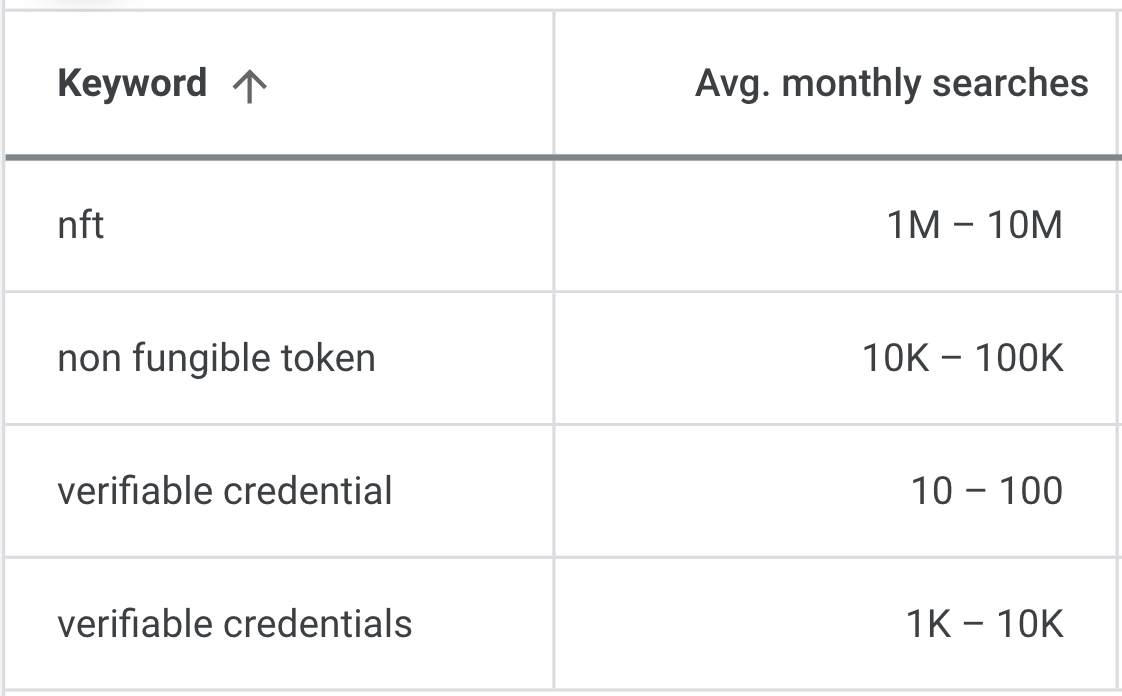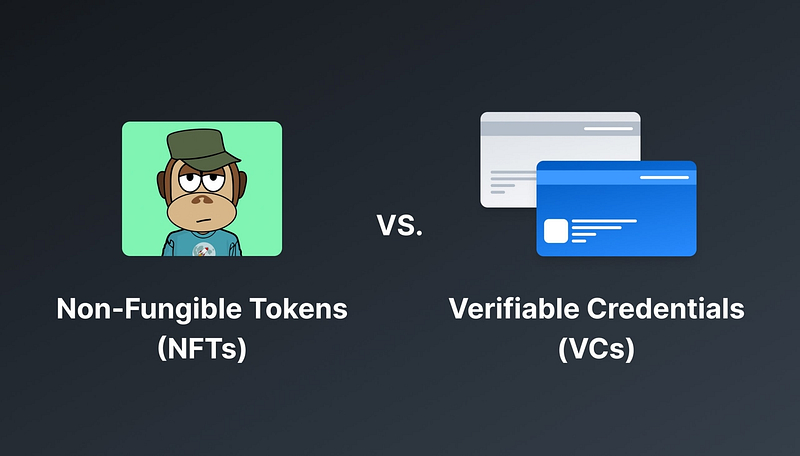An In-depth Guide Comparing Non-Fungible Tokens (NFTs) and Verifiable Credentials (VCs)
Table of Contents
Why We Need a Better System for Digital Identity (Tomislav’s Story)
When my co-founder Tomislav applied to move to a new apartment, they requested his personal information to prove he would be eligible and able to pay rent. He sent in photographs of his government ID, marriage certificate, bank statements, and more. Someone at the rental agency tried to take his information and withdraw his life’s savings from his bank account.
At Trinsic we’re obsessed with creating a new paradigm that allows people to share personal information in a convenient and privacy-preserving manner. Verifiable credentials make this possible, but people are just beginning to understand what VCs are and what they enable. This post will examine the world of verifiable credentials and answer a number of common questions that people have when exploring the space of decentralized identity.
A Quick Definition of Digital Identity
Both NFTs and verifiable credentials have attracted people who are interested in the future of digital identity, so we’re doing a deep dive on the benefits and drawbacks of both technologies.
First, a definition for Identity:
- Identity = identifiers + attributes
Here’s what this equation has looked like over time:
- Physical example: name (identifier) + hair color, height, occupation (attributes)
- Web2 example: username or email (identifier) + profile picture, bio, posts (attributes)
- Web3 example: Public cryptocurrency wallet address (identifier) + NFTs and tokens you hold (attributes)
- Decentralized identity example: DID address (identifier) + verifiable credentials (attributes)
What Are Verifiable Credentials?
Verifiable credentials are data containers for personal information. They are JSONs (Java Script Object Notation) with semantic meaning and structured schema signed by a public-private key pair. Timothy Ruff has compared them to shipping containers. While shipping containers revolutionized the world, they also don’t seem very revolutionary to the average person. The same thing goes for how our data flows online.
Verifiable credentials standardize the format of information allowing you to own your data and selectively share it with relevant parties across the internet. Instead of hosting information in siloes that only interact through API integrations, VCs put the power back in your own hands.
What Are Non-Fungible Tokens?
Non-Fungible Tokens are unique representations of an asset on a blockchain, like Ethereum or Solana. NFTs can be bought and sold in marketplaces like OpenSea and Magic Eden. Thus far, NFTs have frequently been speculative “assets” used to represent community memberships, profile pictures, art, metaverse land, and more. NFTs are blockchain-specific, so a token that is on the Ethereum blockchain cannot be transferred to the Solana blockchain.
Implications of Verifiable Credentials
Verifiable credentials allow you to own your data, making the process of sharing your data easier and more privacy-preserving. For example, sharing verifiable credentials could make the process of applying for an apartment easier. The purpose of checking documentation like bank statements and identity documents is to prove that you are who you say you are, and you can be trusted to pay rent. Currently, you have to show documentation and identification to each individual vendor you’re applying to. Instead, imagine that you held credentials in a digital wallet that could provide assurances about your identity and trustworthiness to pay rent.
Rather than sharing all of your personal information with each apartment vendor, you could share a cryptographic proof that you can pay rent. Concretely, what would be needed to make this a reality would be a trusted issuer, like a bank, who already has access to your financial history and could issue you a credential verifying that you’re able to pay monthly rent up to a certain amount each month. Now, instead of sharing documentation with the apartment vendor, you can instead share the credential and the apartment vendor can verify its legitimacy. The result is a more privacy-preserving system for sharing personal information.
Implications of Non-Fungible Tokens
We’re seeing NFTs used primarily as a form of purchasable membership pass, allowing people special access to channels in a Discord server or to exclusive parties at events like NFT NYC. People also use NFTs as profile pictures and social signals on platforms like Twitter. NFTs could also be used in video games, allowing people to own in-game assets and monetize in new ways. Additionally, there are people selling their digital art as NFTs, giving them access to a worldwide audience of potential collectors.
NFTs facilitate the seamless buying and selling of digital assets. Because they are closely tied with blockchains, and often associated with speculative value, NFTs are inherently financial. Anyone can make an “offer” on an NFT that you own. You pay fees to buy or even transfer NFTs on most blockchains.
Technical Differences Between NFTs and VCs
Public Wallet Addresses vs. Decentralized Identifiers (DIDs)
NFTs are associated with static, public wallet addresses. So if I were to share my wallet address, you would be able to view every NFT that I own and have ever owned. This is beneficial for displaying your collection but has obvious downsides for privacy. Public wallet addresses are not a great place to store your private data.
Verifiable credentials are associated with decentralized identifiers (DIDs). VCs are not publicly viewable but instead are selectively shared with verifying parties as needed. You can have a VC issued to your wallet without the whole internet knowing. While you can make your DID public, which is very useful if you are issuing and signing credentials as a trusted authority, you can also rotate DIDs as a user interacting with different vendors.
The Role of Cryptographic Signatures
Since NFTs are associated with public addresses, you can easily check if someone’s wallet address holds a certain asset. The importance of cryptographic signatures is to prove that you are the person who is in control of the wallet. For example, if you go to an event and you are only allowed in if you hold a certain NFT, you will have to cryptographically sign a message from the wallet that holds the NFT to prove you’re the real owner.
When dealing with verifiable credentials, it’s not publicly known which VCs are associated with which DIDs. If you needed to hold a certain credential to enter an event, the vendor would request a cryptographic proof that you hold the required credential. You would then have the option to share the credential with that vendor, and they can check the legitimacy of the proof. Your information would only be shared with the event host and would otherwise remain encrypted and private to you.
How Blockchain Relates to NFTs and VCs
NFTs are minted on specific blockchains, establishing a unique identifying address and a link to the digital asset. When transferred, NFTs must pay ledger fees to move them on their specific blockchain. NFTs are moved from public address to public address in easily trackable transactions. Blockchains are required and used for any minting and transferring of an NFT.
In comparison, verifiable credentials are issued to digital wallets, where the credentials are stored and can only be accessed by the wallet owner. Verifiable credentials are not tracked by their movement on a blockchain, and you would have no way of knowing another user received a verifiable credential, or if they presented a credential to a third party. Blockchains are not required for exchanging verifiable credentials, but layer-2 networks like Ion, built on top of Bitcoin, can provide an additional level of security when creating DIDs.
How NFTs and VCs Could Impact Our Digital Identities
Key Benefits of NFTs in Digital Identity
NFTs are great for public and transferrable digital assets. Blockchains allow you to show that a specific wallet address owns a digital item. For example, we know that the owner of Cryptopunk #5822 is the Ethereum address 0xe648730be51893acd0045522a0830ec5399ae74c. This is great for showcasing a collection of things like art and membership passes. For this reason, NFTs can help to establish your reputation publicly as a collector, investor, community member, or donor.
NFTs also provide a monetization strategy for artists, designers, and community builders, allowing them to tap into a global, decentralized market. The combination of public display and financial speculation has created viral marketing loops, leading to a large interest in NFTs over the past two years.
Biggest Drawbacks of NFTs in Digital Identity
You would not want to represent identifying documents as NFTs. You cannot “prove” claims about yourself such as “I am 21 years old” using an NFT. Even if the US government issued everyone an ID card NFT, you could sell it.
Note: It is possible to turn off the “transferability” function in a non-fungible token contract. These assets are often referred to as “Soul Bound Tokens” (SBTs) which means they are forever tied to a specific public wallet address. SBTs have more potential for use in an identity context but risk making private information like your date of birth and address public.
Since NFTs are tied to blockchains, you incur fees when transferring them. Thus, if you were to issue tickets to an event as NFTs, you would have an additional cost of paying fees to send the tickets to every attendee’s address. You’re also tied to the speed of that blockchain to complete the transfer of the ticket.
Key Benefits of VCs in Digital Identity
Verifiable credentials are stored privately in a way that doesn’t save any personal information to a public blockchain. You can selectively share information with relying parties without leaking it to the entire internet. VCs do not have to be tied to a blockchain and can be faster and more scalable for implementing in the real world. Thanks to DIDs and World Wide Web Consortium (W3C) specifications, it’s possible for VCs to be interoperable across different blockchains and even web2 environments. Lastly, VCs are non-transferrable nor purchasable, so you will not run into the issue of someone selling their government-issued ID.
Biggest Drawbacks of VCs in Digital Identity
While privacy and a lack of financial speculation are two huge benefits of using verifiable credentials in digital identity, both factors have limited the social reach and virality of the concept. Search volumes for NFTs are several orders of magnitude higher than for verifiable credentials. When you hear about someone selling an NFT for $10,000 profit, you are likely to look into what’s going on and spend some time understanding the technology.

Verifiable credentials are the more practical technology to digitize our identities and finally allow people to prove who they are on the internet. The challenge of user adoption is on everyone’s mind, and Trinsic is here to make it easy for developers to issue, manage, and verify credentials. If you’re interested, you can get started in our dashboard for free right away.
The Future of Digital Identity Is in Our Hands
Both NFTs and VCs provide new approaches to trust digital information. NFTs allow you to publicly prove that you are the unique owner of a digital asset, whereas VCs allow you to privately prove the legitimacy of a claim made over the internet. At their best, both technologies create new avenues for digital coordination that are more humane, efficient, and user-centric.
The future of digital identity will be determined by builders, developers, designers, community builders, and dreamers. If you want to continue the conversation about the future of digital identity, join our Slack community!








